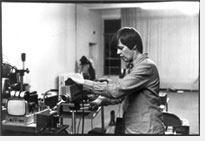

| Exhibition
| Chronology | Works
| Catalog
| Literature
| Press
| Trailer Visitor Information | Program | Partner | Credits | Deutsch |
|
Steina  Steina adopts a unique approach within the history of American video art. As a co-founder of The Kitchen - the legendary performance location for electronic art in New York - she had already positioned herself in the 1970s as an influential personality within the media art scene being generated there.
Up until today, Steina's artistic field of influence is based upon her enthusiasm for video, and in particular upon the potential for generating sound from images and images from sound inherent in that medium. Steina adopts a unique approach within the history of American video art. As a co-founder of The Kitchen - the legendary performance location for electronic art in New York - she had already positioned herself in the 1970s as an influential personality within the media art scene being generated there.
Up until today, Steina's artistic field of influence is based upon her enthusiasm for video, and in particular upon the potential for generating sound from images and images from sound inherent in that medium.The work Violin Power [1970-78] demonstrates this artistic strategy: the specific modulation and interaction of noises and vibrations produced on the violin with the electronic image. With optic-mechanical installations such as Allvision [1976], Steina propagates a rejection of what she understood as the »image imperialism« of the hierarchical relationship between passive consumers of images and the producing artist. As more recent works—such as Trevor [1999] and Warp [2000]-illustrate, she thereby develops a visual language, which playfully and eloquently always articulates anew within the tensional field between nature and technology, naturalism and artificiality. Steina is held to be a protagonist of one tendency within video art, which investigates the basic element of video technology-the electronic signal-as an artistic medium. In videotapes, multi-screen installations, and computer-generated arrangements of machines, up into the present she investigates the way in which the video differentiates from other media. Steina also continued to conduct her impassioned »Dialogue with the Machine« at the Department of Media Study at SUNY, Buffalo during her time there. |
|